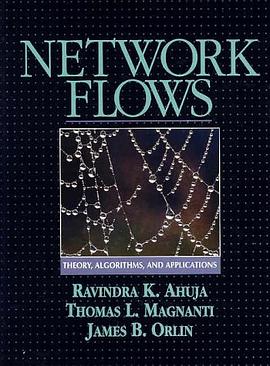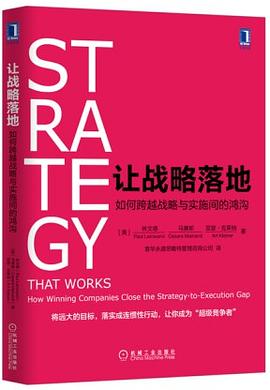Network Flows
内容简介
A comprehensive introduction to network flows that brings together the classic and the contemporary aspects of the field, and provides an integrative view of theory, algorithms and applications.* presents in-depth, self-contained treatments of shortest path, maximum flow, and minimum cost flow problems, including descriptions of polynomial-time algorithms for these core models. * emphasizes powerful algorithmic strategies and analysis tools such as data scaling, geometric improvement arguments, and potential function arguments. * provides an easy-to-understand descriptions of several important data structures, including d-heaps, Fibonacci heaps, and dynamic trees. * devotes a special chapter to conducting empirical testing of algorithms. * features over 150 applications of network flows to a variety of engineering, management, and scientific domains. * contains extensive reference notes and illustrations.
......(更多)
作者简介
......(更多)
目录
CONTENTS
PREFACE, xl
1 INTRODUCTION, 1
1.1 Introduction, 1
1.2 Network Flow Problems, 4
1.3 Applications, 9
1.4 Summary, 18
Reference Notes, 19
Exercises, 20
2 PATHS, TREES, AND CYCLES, 23
2.1 Introduction, 23
2.2 Notation and Definitions, 24
2.3 Network Representations, 31
2.4 Network Transformations, 38
2.5 Summary, 46
Reference Notes, 47
Exercises, 47
3 ALGOlUTHM DESIGN AND ANALYSIS, ~3
3.1 Introduction, 53
3.2 Complexity Analysis, 56
3.3 Developing Polynomial-Time Algorithms, 66
3.4 Search Algorithms, 73
3.5 Flow Decomposition Algorithms, 79
3.6 Summary, 84
Reference Notes, 85
Exercises, 86
4 SHORTEST PA THS: LABEL-SETTING ALGOBITHMS, 93
4.1 Introduction, 93
4.2 Applications, 97
4.3 Tree of Shortest Paths, 106
4.4 Shortest Path Problems in Acyclic Networks, 107
4.5 Dijkstra's Algorithm, 108
4.6 Dial's Implementation, 113
4.7 Heap Implementations, 115
4.8 Radix Heap Implementation, 116
v
4.9 Summary, 121
Reference Notes, 122
Exercises, 124
15 SHORTEST PATHS: LABEL-COBBECTING ALGOBITHMS, 133
5.1 Introduction, 133
5.2 Optimality Conditions, 135
5.3 Generic Label-Correcting Algorithms, 136
5.4 Special Implementations of the Modified Label-Correcting Algorithm, 141
5.5 Detecting Negative Cycles, 143
5.6 All-Pairs Shortest Path Problem, 144
5.7 Minimum Cost-to-Time Ratio Cycle Problem, 150
5.8 Summary, 154
Reference Notes, 156
Exercises, 157
8 MAXIMUM FLOWS: BABIC IDEAS, 188
6.1 Introduction, 166
6.2 Applications, 169
6.3 Flows and Cuts, 177
6.4 Generic Augmenting Path Algorithm, 180
6.5 Labeling Algorithm and the Max-Flow Min-Cut Theorem, 184
6.6 Combinatorial Implications of the Max-Flow Min-Cut Theorem, 188
6.7 Flows with Lower Bounds, 191
6.8 Summary, 196
Reference Notes, 197
Exercises, 198
7 MAXIMUM FLOWS: POLYNOMIAL ALGOBITHMB, 207
7.1 Introduction, 207
7.2 Distance Labels, 209
7.3 Capacity Scaling Algorithm, 210
7.4 Shortest Augmenting Path Algorithm, 213
7.5 Distance Labels and Layered Networks, 221
7.6 Generic Preflow-Push Algorithm, 223
7.7 FIFO Preflow-Push Algorithm, 231
7.8 Highest-Label Preflow-Push Algorithm, 233
7.9 Excess Scaling Algorithm, 237
7.10 Summary, 241
Reference Notes, 241
Exercises, 243
8 MAXIMUM FLOWS: ADDITIONAL TOPICS, 2lJO
8.1 Introduction, 250
8.2 Flows in Unit Capacity Networks, 252
8.3 Flows in Bipartite Networks, 255
8.4 Flows in Planar Undirected Networks, 260
8.5 Dynamic Tree Implementations, 265
vi Contents
8.6 Network Connectivity, 273
8.7 All-Pairs Minimum Value Cut Problem, 277
8.8 Summary, 285
Reference Notes, 287
Exercises, 288
9 MINIMUM COST FLOWS: BABIC ALGOBITHMS, 294
9.1 Introducti"on, 294
9.2 Applications, 298
9.3 Optimality Conditions, 306
9.4 Minimum Cost Flow Duality, 310
9.5 Relating Optimal Flows to Optimal Node Potentials, 315
9.6 Cycle-Canceling Algorithm and the Integrality Property, 317
9.7 Successive Shortest Path Algorithm, 320
9.8 Primal-Dual Algorithm, 324
9.9 Out-of-Kilter Algorithm, 326
9.10 Relaxation Algorithm, 332
9.11 Sensitivity Analysis, 337
9.12 Summary, 339
Reference Notes, 341
Exercises, 344
10 MINIMUM COST FLOWS: POLYNOMIAL ALGORITHMS, 8lJ7
10.1 Introduction, 357
10.2 Capacity Scaling Algorithm, 360
10.3 Cost Scaling Algorithm, 362
10.4 Double Scaling Algorithm, 373
10.5 Minimum Mean Cycle-Canceling Algorithm, 376
10.6 Repeated Capacity Scaling Algorithm, 382
10.7 Enhanced Capacity Scaling Algorithm, 387
10.8 Summary, 395
Reference Notes, 396
Exercises, 397
11 MINIMUM COST FLOWS: NETWORK SIMPLEX ALGO.RlTHMS, 402
11.1 Introduction, 402
11.2 Cycle Free and Spanning Tree Solutions, 405
11.3 Maintaining a Spanning Tree Structure, 409
11.4 Computing Node Potentials and Flows, 411
11. 5 Network Simplex Algorithm, 415
11.6 Strongly Feasible Spanning Trees, 421
11.7 Network Simplex Algorithm for the Shortest Path Problem, 425
11.8 Network Simplex Algorithm for the Maximum Flow Problem, 430
11.9 Related Network Simplex Algorithms, 433
11.10 Sensitivity Analysis, 439
11.11 Relationship to Simplex Method, 441
11.12 U nimodularity Property, 447
11.13 Summary, 450
Reference Notes, 451
Exercises, 453
Contents vii
12 ABSIGNMENTSANDMATCHINGS, 481
12.1 Introduction, 461
12.2 Applications, 463
12.3 Bipartite Cardinality Matching Problem, 469
12.4 Bipartite Weighted Matching Problem, 470
12.S Stable Marriage Problem, 473
12.6 Nonbipartite Cardinality Matching Problem, 475
12.7 Matchings and Paths, 494
12.8 Summary, 498
Reference Notes, 499
Exercises, 501
13 MINIMUM SPANNING TREES, 1510
13.1 Introduction, 510
13.2 Applications, 512
13.3 Optimality Conditions, 516
13.4 Kruskal's Algorithm, 520
13.S Prim's Algorithm, 523
13.6 Sollin's Algorithm, 526
13.7 Minimum Spanning Trees and Matroids, 528
13.8 Minimum Spanning Trees and Linear Programming, 530
13.9 Summary, 533
Reference Notes, 535
Exercises, 536
14 CONVEX COST FLOWS, 1543
14.1 Introduction, 543
14.2 Applications, 546
14.3 Transformation to a Minimum Cost Flow Problem, 551
14.4 Pseudopolynomial-Time Algorithms, 554
14.S Polynomial-Time Algorithm, 556
14.6 Summary, 560
Reference Notes, 561
Exercises, 562
15 GENEBALIZED FLOWS, 1588
IS.1 Introduction, 566
IS.2 Applications, 568
15.3 Augmented Forest Structures, 572
IS.4 Determining Potentials and Flows for an Augmented Forest Structure, 577
IS.S Good Augmented Forests and Linear Programming Bases, 582
IS.6 Generalized Network Simplex Algorithm, 583
IS.7 Summary, 591
Reference Notes, 591
Exercises, 593
viii Contents
16 LAGRANGIAN RELAXATION AND NETWORK OPTIMIZATION, 698
16.1 Introduction, 598
16.2 Problem Relaxations and Branch and Bound, 602
16.3 Lagrangian Relaxation Technique, 605
16.4 Lagrangian Relaxation and Linear Programming, 615
16.5 Applications of Lagrangian Relaxation, 620
16.6 Summary, 635
Reference Notes, 637
Exercises, 638
17 MULTICOMMODITY FLOWS, 849
17.1 Introduction, 649
17.2 Applications, 653
17.3 Optimality Conditions, 657
17.4 Lagrangian Relaxation, 660
17.5 Column Generation Approach, 665
17.6 Dantzig-Wolfe Decomposition, 671
17.7 Resource-Directive Decomposition, 674
17.8 Basis Partitioning, 678
17.9 Summary, 682
Reference Notes, 684
Exercises, 686
18 COMPUTATIONAL TESTING OF ALGOlUTHMS, 896
18.1 Introduction, 695
18.2 Representative Operation Counts, 698
18.3 Application to Network Simplex Algorithm, 702
18.4 Summary, 713
Reference Notes, 713
Exercises, 715
19 ADDITIONAL APPLICATIONS, 717
19.1 Introduction, 717
19.2 Maximum Weight Closure of a Graph, 719
19.3 Data Scaling, 725
19.4 Science Applications, 728
19.5 Project Management, 732
19.6 Dynamic Flows, 737
19.7 Arc Routing Problems, 740
19.8 Facility Layout and Location, 744
19.9 Production and Inventory Planning, 748
19.10 Summary, 755
Reference Notes, 759
Exercises, 760
Contents Ix
APPENDIX A DATA STBUCTUBES, 78~
A.I Introduction, 765
A.2 Elementary Data Structures, 766
A.3 d-Heaps, 773
A.4 Fibonacci Heaps, 779
Reference Notes, 787
APPENDIX B Nf/I-COMPLETENESS, 788
B.I Introduction, 788
B.2 Problem Reductions and Transformations, 790
B.3 Problem Classes r;p, ,Nr;p, ,Nr;p-Complete, and ,Nr;p-Hard, 792
B.4 Proving ,Nr;p-Completeness Results, 796
B.5 Concluding Remarks, 800
Reference Notes, 801
APPENDIX C LINEAR PROGRAMMING, 802
C.I Introduction, 802
C.2 Graphical Solution Procedure, 804
C.3 Basic Feasible Solutions, 805
C.4 Simplex Method, 810
C.S Bounded Variable Simplex Method, 814
C.6 Linear Programming Duality, 816
Reference Notes, 820
BEFEBENCES, 821
INDEX, 840
......(更多)
读书文摘
......(更多)






